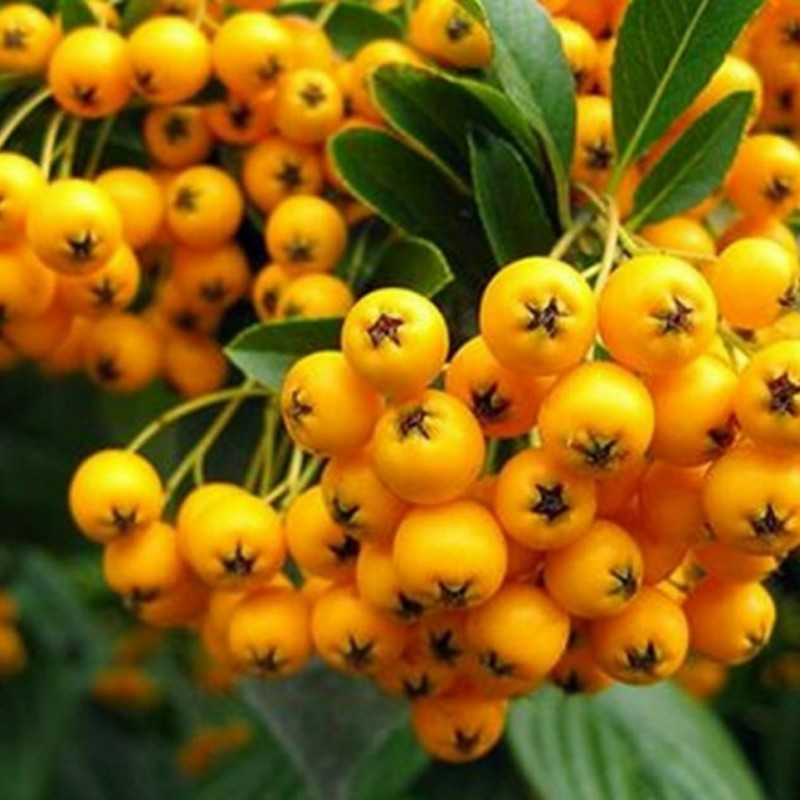Scarlet Firethorn Seeds (Pyracantha coccinea) Hardy
Price for Package of 20 seeds.
Scarlet Firethorn is a large, fast growing, semi-evergreen to evergreen shrub that is cherished for its spectacular fall and winter display of scarlet fruits and ability to withstand difficult conditions. Shooting long limber stems in all directions, an untrained Firethorn, typically grows into a tangled mound up to 18 feet in height and 12 feet wide. It is armed with sharp thorns that hide among the dark, glossy green leaves. Abundant clusters (corymbs) of small white flowers appear in spring. The flower clusters are up to 2 inches across and are borne close together creating the appearance of nearly solid surface of flowers. In fall the 1/4 inch berries begin to ripen, their color mellowing from green to shades of red and orange. These persist through winter and into early spring depending on climate and appetite of the local bird population. The prolific flowers are lovely to behold and have some fragrance (although not all would agree that it is appealing). Birds, especially cedar waxwings, like the plump, colorful berries. The brilliant berry-laden branches of Firethorn hold up extremely well in cut arrangements and add interest and color to wreaths.
Firethorn is often used as an espalier. Held flat against a wall, it can be shaped quite creatively. Landscapers love the firethorns for their fast rate of growth and ability to withstand drought and neglect. The shrubs ruggedness and disease and pest resistance makes this plant a very popular item in commercial landscapes. The wide-reaching stems may be pruned back as needed during warm weather as the shrub blooms on old wood. Consider using it as a formal or informal hedge. This will require some trimming and shaping for the first few years but the effort will produce impressively beautiful and secure (thorny) hedges.
Leaf: Alternate, simple, oblong to lanceolate, serrated margin, 1 to 2 inches long, semi-evergreen to evergreen, shiny, dark green above, paler and pubescent below.
Flower: Creamy white, 5 petals, 1/3 inch across in tight clusters several inches across, appearing in late spring to early summer.
Fruit: Small pome, 1/4 inch across, bright orange-red, occurring in tight clusters, very showy, ripens in late summer and persists through the winter.
Twig: Slender, initially pubescent, later glaborous, red-brown, numerous spines, small buds.
Bark: Smooth reddish brown with numerous lenticels.
Form: Upright, open shrub with stiff limbs and thorns, can reach 18 feet tall.
Other Names: Scarlet Firethorn
Zone: 5 to 9 In moderate to severe zone 5 winters, the bronzed broadleaf evergreen foliage will severely "burn" or die, and stem dieback may occur anywhere from tip dieback all the way to the snowline.
Growth Rate: Fast to Moderate
Plant Type: Semi-evergreen to evergreen shrub
Family: Rosaceae
Native Range: Europe, Southwestern Asia
Height: 10 to 18 feet
Spread: 10 to 18 feet
Shape: Variable from upright and spreading to arching and irregular. Can become open without pruning.
Bloom Time: May
Bloom Color: White
Sun: Sun to Part Shade
Fall Color: Bronze to Evergreen
Drought Tolerance: Moderate to High (once established)
Water: Medium
Maintenance: Low to Moderate
Site Requirements/Soil Tolerances: Prefers moist, well-drained soils in full sun, but is very urban tolerant and adaptable to poor soils, compacted soils, soils of various pH, heat, drought, and heavy pruning. Will grow in partial to fairly heavy shade, however, flowering and fruiting will not be as heavy.
Culture: Difficult to prune because of thorns. Best time to prune vigorously growing specimens or espaliers is either right after bloom (to set up flower buds and fruits for the following year) or in autumn or early spring (to gain firm control with heavy pruning, and forego flowering and fruiting for an entire year).
Uses: Hedge/Screen, Espalier, Trellis, Bonsai, Crafts.
Hardy, Adaptable, Easy to Grow, Fast Growth, Attracts Birds, Wildlife Food/Shelter, Showy Flowers/Fruit, Hedge/Screen, Espalier, Trellis, Bonsai, Cold, Heat, Drought, Urban and Wind Tolerant
|
Sowing Instructions
|
|
Propagation:
|
Seeds
|
|
Pretreat:
|
soak in water for 24 hours
|
|
Stratification:
|
3-4 months in moist sowing mix at 2-5 ° C refrigerator
|
|
Sowing Time:
|
all year round
|
|
Sowing Depth:
|
3,2 mm - 1/8” (Cover lightly with substrate)
|
|
Sowing Mix:
|
Coir or sowing mix + sand or perlite
|
|
Germination temperature:
|
min. 18° C
|
|
Location:
|
bright + keep constantly moist not wet
|
|
Germination Time:
|
until it germinates
|
|
Watering:
|
Water regularly during the growing season
|
|
|
Copyright © 2012 Seeds Gallery - Saatgut Galerie - Galerija semena. All Rights Reserved.
|









